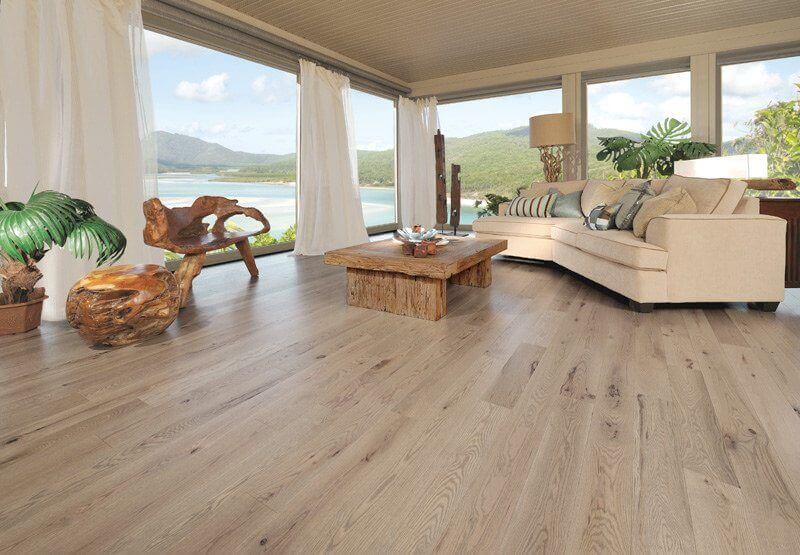The Most Popular Domestic Hardwoods Used on Floors
September 16, 2014
As you can probably surmise from the term, domestic hardwoods are woods from trees that grow in North American forests, primarily in the United States and Canada. These woods comprise some 20 species, mostly grown in the eastern part of the continent where the climate and soil is most suitable for deciduous forests (deciduous trees are the ones with large, broad leaves that change color and fall off in autumn and are the ones that produce denser “hard” wood).

The domestic hardwoods most commonly used for flooring are:
- Red Oak
- White Oak
- Maple
- Hickory
- Black Walnut
- Cherry
- Beech
- Ash
In the U.S., more than half of all hardwood-producing trees are oak, which grows naturally from New England to Mississippi. Oaks nearest competitors are Ash, which makes up only about 11%, and Maple at 8%, while Ash, Cherry, Alder and other species each make up less than 5%, some significantly less. Altogether, these trees make up about 40% of the trees in the U.S.
Domestic hardwoods typically have a warmer look and feel and are a bit more understated than bold exotics. Though exotic species have their place, domestic wood species are coming back into favor in the United States as preferences turn towards natural and rustic looks and toward “buying local” in general. In a recent survey of designers from across the country, almost all of the respondents indicated a domestic species as their hardwood of choice, 43% choosing time-tested classic Oak, 15% percent Walnut, and 14% Hickory. Domestic species are also likely to be more budget-friendly since they do not have to go through lengthy and sometimes expensive importation processes. Plus, it is much easier to ensure that the harvesting of domestic woods has been done in accordance with best practices for sustainability and forest health.
Red Oak
As by far the most abundant domestic hardwood, it is no wonder that Oak in general is also the most popular choice for flooring in this country, and Red Oak in particular. Besides being abundant, and consequently more affordable, Red Oak is one of the most stain-friendly woods around. This means that you can create whatever look you want without breaking the bank, and can change the look later with a simple sand a refinish. Red Oak typically displays moderate to heavy graining with modest color variations. Its natural color tends to range from light creamy reddish pinks (hence “Red” Oak) to shades of brown. And, with a Janka rating of about 1290, Red Oak tends to hold up well under wear but be flexible enough to not crack and split under pressure.
White Oak
Like its tinted sister, White Oak is plentiful and stains well. Its graining is similar and its color variation moderate, but unlike Red Oak, White Oak tends to be more golden brown to gray in color. White Oak is also harder (1360 on the Janka scale), and has proven an exceptionally stable hardwood, a big bonus for flooring.
Maple
Grown primarily in Canada and the northern regions of the U.S., Maple is an especially popular choice for contemporary spaces these days. Though it does not take stain as well as Oak, its creamy natural color, subtle grain pattern, and minimal color variation make it perfect for natural-finish floors. Because Maple timber is less porous, with a Janka rating of 1450 (one of the reasons it is less welcoming to stains), it tends to be somewhat more resistant to dents and scratches.
Hickory
Hickory, maple, and walnut were all strong sellers this year. It seems that Hickory especially is becoming increasingly popular for engineered flooring. This is likely because, when manufactured just so, hickory produces a beautiful, rustic appearance that has become very popular in recent years.
Walnut
Also known as American Black Walnut and variations thereon, Walnut is one of the most beautiful and sophisticated hardwood species grown in North America. The heartwood and sapwood of Walnut vary greatly in color, with the wood from the innermost part of the tree ranging from rich deep brown to almost purplish black. By contrast, wood from the outer rings of the tree tends to be tan to nearly white. Most often, Walnut flooring will have a straight, open grain, but it is also known for the swirling, burled patterns that sometimes appear. Though it is not as hard as some of the other hardwoods (only 1010 on the Janka scale), if you are seeking a refined, classy look for your floors, Walnut may be a good choice.
Cherry
Like Maple, Cherry is a dense hardwood with a very subtle grain that is usually left unstained. Less dramatic than its popular exotic counterpart, Brazilian Cherry, American Cherry has a natural reddish brown color that tends to deepen over time and brings an appealing warmth and richness to a room.
Beech
Beech is one of the lighter feeling domestic hardwoods. It ranges from pale white to reddish brown and has a fine, straight grain, giving it a relatively uniform texture. With a Janka rating of around 1300, it is easily as durable as Red oak but creates a more open, airy feel because of its pale color and understated texture.
Ash
Like Walnut, Ash ranges significantly in color from heartwood, which can be anywhere from light tan to dark brown, to sapwood, which is creamy white. Yellower in tone than other pale woods like White Oak and Beech, Ash is great for bringing warmth to a room while maintaining a light, open feel.














